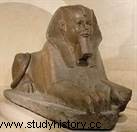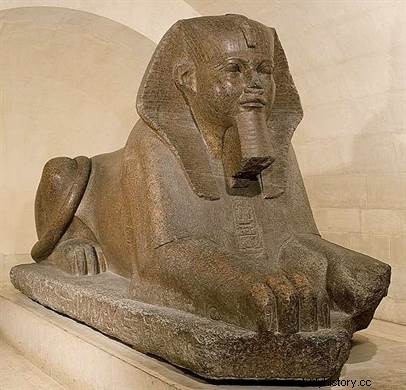 The Great Sphinx of Tanis welcomes you at the entrance to the Egyptian Antiquities department created at the Musée du Louvre , in 1826 by Charles X. This imposing statue of pink granite, weighing twelve tons, measuring four meters eighty in length, one meter fifty in width and height of one meter eighty was found among the ruins of the Temple of Amun -Rê in Tanis, may be the capital of Lower Egypt, east of the Nile Delta, following the deciphering of hieroglyphics by Champollion in 1822.
The Great Sphinx of Tanis welcomes you at the entrance to the Egyptian Antiquities department created at the Musée du Louvre , in 1826 by Charles X. This imposing statue of pink granite, weighing twelve tons, measuring four meters eighty in length, one meter fifty in width and height of one meter eighty was found among the ruins of the Temple of Amun -Rê in Tanis, may be the capital of Lower Egypt, east of the Nile Delta, following the deciphering of hieroglyphics by Champollion in 1822.
The sphinx, living image of the Pharaoh
The "sphinx" is a Greek term meaning Egyptian statues, representing an animal with a human head, but not corresponding to reality. This statue made of symbols, represents a double force:the power and the physical superiority of the lion surmounted by the head of the sovereign the Pharaoh, with his headdress, his false beard and the erect cobra. All Egyptian art resides in this alloy of magic and life.
The lion is lying down, ready to pounce, front legs extended, claws out, hind legs folded and tail curling over the left thigh. In this position, he is always placed at the entrance to palaces and temples, as guardian and protector of places, as defender with the mission of crushing enemies who would like to enter.

The Sphinx of Tanis, Louvre Museum.
The names of Amenemhat II of the Twelfth Dynasty between 1929 and 1895 BC. J.C., Merenptah of the Nineteenth Dynasty between 1212 and 1202 BC. J.C. and Chechonq 1st of the twenty second dynasty between 945 and 924 BC. J.C. are inscribed on the base of the sphinx. Each pharaoh appropriated this statue over time, and this is how the term "usurpation" of the inscriptions is often used.
But according to archaeologists, the sphinx dates from the Old Kingdom, around 2600 BC. J.C. !
